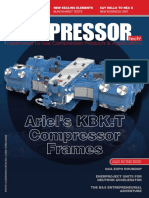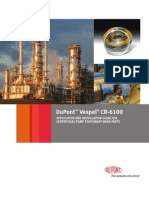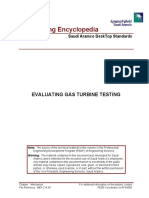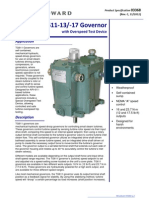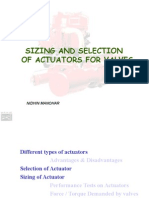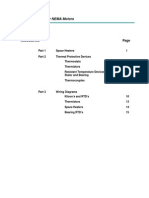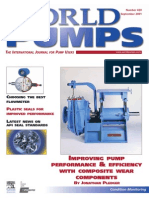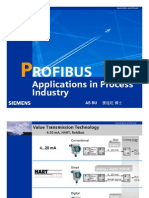API 613 - Turbolab
API 613 - Turbolab
Uploaded by
DelfinshCopyright:
Available Formats
API 613 - Turbolab
API 613 - Turbolab
Uploaded by
DelfinshOriginal Description:
Original Title
Copyright
Available Formats
Share this document
Did you find this document useful?
Is this content inappropriate?
Copyright:
Available Formats
API 613 - Turbolab
API 613 - Turbolab
Uploaded by
DelfinshCopyright:
Available Formats
Robert W.
(Wes) Conner is a Machinery Engineer with Fluor
Daniel in Sugarland, Texas. He has 34 years of experience as a
machinery engineer with operating companies and contractors.
Kenneth O. (Ken) Beckman is Chief
Engineer of the Power Transmission
Division of Lufkin Industries, Inc., in
Lufkin, Texas. Since college graduation he
has been in gear engineering with Lufkin
Industries. He previously served as a
Design Engineer in high-speed gearing,
and in 1985 he was promoted to Chief
Engineer responsible for the engineering
on all gears including low-speed through
high-speed, marine, and repair. Mr.
Beckman has spent a considerable portion of his time working with
users and service departments to solve gearing problems. The
Quality Assurance Department and the Test Stand area were added
to his responsibilities in 1998.
Mr. Beckman received a B.S. degree (Mechanical Engineering,
1972) from Montana State University. He is an active member of
AGMA and API. He is currently on the Advisory Board for the
University of Louisiana at Lafayette.
ABSTRACT
Summary of Purpose for the Standard
API 613 provides a conservative basis for building critical
service process industry turbomachinery gear unit drives. It is
intended to provide gear units that give reliable trouble-free service
when used in challenging operating and environmental conditions.
HISTORY
Before API 613 existed, gear unit drives for process industry
applications were built to American Gear Manufacturers
Association (AGMA) standards or standards of other countries.
These standards established a design basis using analytical tech-
niques with many factors that addressed the potential loads that
could be applied and how those loads would be accommodated by
the gear unit. Working with the gear manufacturers, the American
Petroleum Institute (API) developed a simplified gear element
rating formula that first appeared in API 613, Second Edition, in
1977. API 613, Second Edition, rating methods, based on AGMA
rating formulas, established a conservative set of design parame-
ters factored off of marine propulsion mechanical drive application
practices for ships. This approach established a default design basis
for gear element rating that removed the discretionary selection by
gear designers of rating factors in the rating formulas of the appli-
cable manufacturing standards such as AGMA. This same basic
approach has been carried over to the latest edition of API 613 with
each subsequent revision since API 613, Second Edition, based on
the latest applicable AGMA standards. Since 1977, the gear units
manufactured to API 613, have proven to be very reliable and have
met user expectations consistent with availability requirements
necessary for the industries in which they are applied.
REVIEW OF CONTENT
Scope
The Standard covers special purpose enclosed precision single
and double helical one- and two-stage speed increasers and
reducers of parallel shaft design for petroleum, chemical, and gas
industry services. The Standard is primarily intended for gear units
that are in continuous service applications without installed spare
equipment.
Typical applications where these gear units are applied include:
Centrifugal compressors and rotary positive displacement com-
pressors.
Blowers and fans.
Centrifugal pumps.
Reciprocating compressors.
Extruders and mixers.
Generators.
Gear Element Rating Methods
Gear element load ratings are based on tooth pitting index (K)
and bending stress number (S) at rated power, times a service
factor based on the application. Tooth pitting index corresponds to
a contact surface stress number. It is used to determine a load rating
at which progressive pitting of the gear teeth will not occur during
their design life. Bending stress number is calculated at the tooth
root filet and is designed to be below the maximum allowable
stress possible without fatigue cracking. API 613, Fifth Edition,
recommended service factors range from a low of 1.1 for a base
load generator to as high as 2.3 for reciprocating pumps driven by
reciprocating engines.
135
API 613, FIFTH EDITION, SPECIAL PURPOSE
GEAR UNITS FOR PETROLEUM, CHEMICAL AND GAS INDUSTRY SERVICES
OVERVIEW PRESENTATION
by
Robert W. (Wes) Conner
Machinery Engineer
Fluor Daniel
Sugarland, Texas
and
Kenneth O. (Ken) Beckman
Chief Engineer, Power Transmission Division
Lufkin Industries, Inc.
Lufkin, Texas
The API 613 calculations for tooth pitting index and bending
stress are based on AGMA methods with a preselected set of
design factors applied to ensure conservative rating under the load
conditions for the application. A detailed comparison of API 613
versus AGMA 2101 (1996) rating factors and calculation methods
is included in Appendix J of API 613 (attached for reference under
APPENDIX A).
One way to present the difference between the size of the gear-
set per API 613 and AGMA 6011 (1998) is to pictorially represent
them. Illustrated in Figure 1 is a 20,000 horsepower reference unit
with an API 613 gear-set on the left and an AGMA 6011 gear-set
on the right, both with a service factor of 1.1 The AGMA 6011
gear-set scale is 79 percent of the size of the API 613 gear-set.
Figure 1. Illustration of Relative Sizes of API 613 Versus AGMA
6011 for Equivalent Design Conditions.
Gear elements designed based on tooth pitting index and
bending stress are also checked per AGMA 6011 (1998) to ensure
scuffing avoidance when provided with lubricants that do not
contain extreme pressure additives. Scuffing is a damaging
condition that can happen when relative movement occurs between
gear tooth contact surfaces upon loss of lubricant film.
Casings
API 613 (2003) gearbox casings can be made of either cast-iron
or fabricated steel but both require stress relief before final
machining. In addition, casings are required to be designed to
permit removing the top half without disturbing the oil piping in
the bottom half of the casing.
Gear Elements and Shafts
API 613 (2003) requires pinions to be integrally forged with the
shaft.
Gear wheels (bull gears) can be integrally forged with the shaft
or have a one piece forged hub and rim or have a forged rim and
fabricated hub and must be shrunk on the shaft with an interference
fit. API 613 provides limits for each of the gear wheel fabrication
options based on gear tooth pitch line velocity.
Gear wheel shafts are required to be machined from one piece of
heat treated steel.
API 613 (2003) requires that a pair of mating gears have a
hunting tooth combination, so a tooth on the pinion does not repeat
contact with a tooth on the gear wheel until it has contacted all of
the other gear wheel teeth. This is to ensure even wear on all teeth.
Each gear element is checked separately for accuracy after final
machining per AGMA/ISO 1328-1 (1999).
Each pair of mating gears is checked for contact after final
machining on a contact checking stand and in the job casing at the
vendors shop. This is done by applying a color transfer material
such as Prussian blue at three locations 120 degrees apart to four or
more teeth per location. The shafts are then rotated through the
mesh, while applying a moderate drag torque, in a direction that
will cause them to contact on the normally loaded faces. API 613
(2003) requires that the vendor provide the purchaser with a
drawing or specification that defines acceptable contact.
Unmodified gear teeth generally show a minimum of 80 percent
contact across the tooth length.
Every gear under loaded operating conditions is subject to
deformation of the entire rotor in three ways including bending
deflection, torsional windup, and thermal distortion. Guidelines
are included in API 613 (2003) for when to modify gear teeth
with lead or profile modifications to provide the desired gear
tooth contact under operating conditions. Contact check profile
drawings are very important for gears with modified teeth to
confirm that the contact pattern is consistent with the as-designed
condition.
Illustrations of the effects of the loads that can create a need for
lead or profile modifications along with the resulting modifications
are contained in API 613 (2003) Appendix H, Figures H-1 and H-
2 (attached for reference under APPENDIX B).
Gear Materials
Gear element materials are required to be forged or hot rolled
alloy steel typically selected from grades identified in Appendix E
of API 613 (2003). Also, material quality grades referenced to ISO
6336-5 (1996) are defined for the tooth hardening method to be
applied. Guidelines for application of hardening by through-
hardened, carburized, or nitrided methods are defined in API 613.
A few users prefer to specify through-hardened gears, even though
it may result in a larger gear unit than with other hardening
methods, to provide the opportunity to increase the gear unit load
rating in the future by going to carburized or nitrided gear
elements.
Dynamics
A train torsional analysis of the complete coupled train
including the gear unit is done by the vendor having unit responsi-
bility. The gear unit manufacturer is required to provide the gear
mass elastic data required for the torsional analysis.
A gear unit undamped lateral analysis is conducted by the gear
unit manufacturer to identify the undamped critical speeds and
determine their mode shapes in the range of zero percent to 125
percent of trip speed. When the specified minimum operating con-
ditions are less than 40 percent of the gear unit power or less than
70 percent of the maximum continuous speed or the undamped
analysis indicates the first critical is less than 120 percent of the
maximum continuous speed, the manufacturer is required to
conduct a damped unbalanced response in addition to the
undamped analysis. When an unbalanced response analysis is
required, an unbalance response test must be performed as part of
the mechanical running test and the results used to verify the ana-
lytical model.
Pinion and gear wheel (bull gear) assemblies are required to be
multiplane dynamically balanced to a maximum residual
unbalance level of 4W/N.
Bearings
Radial bearings are required to be hydrodynamic bearings of the
sleeve or pad type. They must be axially split and steel backed with
babbitted replaceable liners, pads, or shells. Bearing liners, pads,
or shells are to be mounted in axially split bearing housings and are
to be replaceable without having to remove the coupling hub.
Thrust bearings are required to be steel backed multisegment
type designed for equal thrust capacity in both directions and
arranged for continuous pressurized lubrication to each side.
Integral thrust collars are preferred per API 613 (2003) and when
replaceable collars are provided they must be positively locked to
the shaft to prevent fretting.
Thrust bearings and radial bearings are required to be provided
with bearing temperature sensors installed as specified in API 670
(2000).
Shaft radial vibration probes and axial position probes are
required along with a one event per revolution probe on the input
and output shafts installed per API 670 (2000).
PROCEEDINGS OF THE THIRTY-THIRD TURBOMACHINERY SYMPOSIUM 2004 136
Lubrication
API 613 (2003) requires gear units to be pressure lubricated and
provided with spray nozzles for the gear teeth. Oil systems for API
613 gear units are usually supplied by the driven equipment train
manufacturer and are typically designed for ISO VG 32 mineral oil
though synthetic lubricants are permitted when specified by the
purchaser. When the lube oil system is supplied by the gear unit
manufacturer, it is required to be designed to API 614 (1999),
Chapter 2, special purpose oil system requirements.
Couplings
API 613 (2003) requires flexible couplings to be supplied by the
driven equipment manufacturer per API 671 (1998) unless
otherwise specified by the purchaser. Integral flange hubs are
required as an API 613 default that eliminates coordination of fits
of the hub to the shaft and keeps overhang low, which aids the
lateral rotordynamics.
Piping
Piping is usually limited on API 613 gear units, but external
piping that is provided defaults to the requirements defined in API
614 (1999).
Instrumentation
Instrumentation requirements default to API 670 (2000) for
vibration and temperature measurement and monitoring and to API
614 (1999) for other types of commonly applied instrumentation.
Testing
A four hour no load at-speed mechanical run test is required as
a minimum for all API 613 gear units.
Optional purchaser specified tests include:
Full speed/full or part load testMost manufacturers are limited
to a part load test on larger gear units by shop driver size limita-
tions.
Full torque/reduced speed testWhen a full speed full load test
cannot be performed, a full torque reduced speed test may be
performed to demonstrate loaded tooth contact patterns.
Full torque/static testThis test would normally only be of
value to check the effects of lead modification and then only if the
lead modification was for reasons other than thermal distortion,
since the test would not get the gear teeth to operating tempera-
tures.
Back-to-back locked torque testThis test involves two contract
gear units with one serving as the test unit and the other as a drive
or slave unit. It is typically done for new or modified product lines
where fine tuning of lead modifications is necessary to get the
results desired.
Sound level testSound level tests are usually done for all at-
speed testing, but meaningful data that reflect expectations at site
conditions is difficult to achieve unless the gear unit is fully loaded
on test.
API 613, FIFTH EDITION, SPECIAL PURPOSE GEAR UNITS FOR PETROLEUM,
CHEMICAL AND GAS INDUSTRY SERVICESOVERVIEW PRESENTATION
137
APPENDIX A
Appendix J is reproduced here courtesy of API.
PROCEEDINGS OF THE THIRTY-THIRD TURBOMACHINERY SYMPOSIUM 2004 138
API 613, FIFTH EDITION, SPECIAL PURPOSE GEAR UNITS FOR PETROLEUM,
CHEMICAL AND GAS INDUSTRY SERVICESOVERVIEW PRESENTATION
139
APPENDIX B
Appendix H figures are reproduced here courtesy of API.
PROCEEDINGS OF THE THIRTY-THIRD TURBOMACHINERY SYMPOSIUM 2004 140
API 613, FIFTH EDITION, SPECIAL PURPOSE GEAR UNITS FOR PETROLEUM,
CHEMICAL AND GAS INDUSTRY SERVICESOVERVIEW PRESENTATION
141
REFERENCES
AGMA 2101, 1996, Fundamental Rating Factors and Calculation
Methods for Involute Spur and Helical Gear Teeth, American
Gear Manufacturers Association, Alexandria, Virginia.
AGMA/ISO 1328-1, 1999, Cylindrical GearsISO System of
AccuracyPart 1: Definitions and Allowable Values of
Deviations Relevant to Corresponding Flanks of Gear Teeth,
American Gear Manufacturers Association, Alexandria,
Virginia/International Organization for Standardization,
Geneva, Switzerland.
ANSI/AGMA 6011-H98, 1998, Specifications for High Speed
Helical Gear Units, American National Standards Institute,
Washington, D.C./American Gear Manufacturers Association,
Alexandria, Virginia.
API Standard 613, 2003, Special-Purpose Gear Units for
Petroleum, Chemical and Gas Industry Services, Fifth
Edition, American Petroleum Institute, Washington, D.C.
API Standard 614, 1999, Lubrication Shaft-Sealing and Control-
Oil Systems for Special-Purpose Applications, Fourth
Edition, American Petroleum Institute, Washington, D.C.
API Standard 670, 2000, Vibration, Axial-Position, and Bearing-
Temperature Monitoring Systems, Fourth Edition, American
Petroleum Institute, Washington, D.C.
API Standard 671, 1998, Special Purpose Couplings for
Petroleum, Chemical, and Gas Industry Services, Third
Edition, American Petroleum Institute, Washington, D.C.
ISO 6336-5, 1996, Calculation of Load Capacity of Spur and
Helical GearsPart 5, International Organization for
Standardization, Geneva, Switzerland.
PROCEEDINGS OF THE THIRTY-THIRD TURBOMACHINERY SYMPOSIUM 2004 142
You might also like
- OM601 Servisn ManulDocument370 pagesOM601 Servisn ManulAndriatsitohaina Rabenaivo89% (9)
- 6th Central Pay Commission Salary CalculatorDocument15 pages6th Central Pay Commission Salary Calculatorrakhonde100% (436)
- Oil Mist Lubrication TrainingDocument70 pagesOil Mist Lubrication TrainingDelfinsh100% (4)
- Grundfos Alignment-White PaperDocument21 pagesGrundfos Alignment-White PaperDelfinshNo ratings yet
- 9258 - Operations Management-FrameworkDocument26 pages9258 - Operations Management-FrameworkKristi HerreraNo ratings yet
- API 682 4th Edition Category 1 Configurations: 3CW-FBDocument19 pagesAPI 682 4th Edition Category 1 Configurations: 3CW-FBtuliofilipeNo ratings yet
- (Paper) (Balancing of Integral Gear-Driven Centrifugal Compressors)Document8 pages(Paper) (Balancing of Integral Gear-Driven Centrifugal Compressors)aref_tmuNo ratings yet
- Rotor DynamicsDocument43 pagesRotor Dynamicslopes_anderson5078No ratings yet
- Orbit V31N1 2011 Q1Document60 pagesOrbit V31N1 2011 Q1KrishnaNo ratings yet
- Compressor Cond MonDocument33 pagesCompressor Cond MonJai Gaizin100% (1)
- Compressortech2 May2018 PDFDocument60 pagesCompressortech2 May2018 PDFCristian SNo ratings yet
- Is Rod Drop The Right Measurement For My Reciprocating Compressor?Document4 pagesIs Rod Drop The Right Measurement For My Reciprocating Compressor?Sagar MishraNo ratings yet
- T1pg39-55 FLUID FILM BEARING DESIGN CONSIDERATIONS PDFDocument17 pagesT1pg39-55 FLUID FILM BEARING DESIGN CONSIDERATIONS PDFGustavo CuatzoNo ratings yet
- Sundyne Pumps & Compressors Training Course: THREE DAYS (Theoretical and Practical)Document3 pagesSundyne Pumps & Compressors Training Course: THREE DAYS (Theoretical and Practical)önder KarakayaNo ratings yet
- Fluid Film Bearing Damage Poster 1668361770Document1 pageFluid Film Bearing Damage Poster 1668361770Amna YahyaNo ratings yet
- Compressors Valves Reprint eDocument8 pagesCompressors Valves Reprint eNavigator VirgoNo ratings yet
- Controlling Coupling Guard Leakage: Rotating Equipment/MaintenanceDocument3 pagesControlling Coupling Guard Leakage: Rotating Equipment/MaintenanceinterveiwNo ratings yet
- Orbit V33N3 2013 Q3Document64 pagesOrbit V33N3 2013 Q3Adhitya DwijayanthoNo ratings yet
- Dupont Vespel Cr-6100: Application and Installation Guide For Centrifugal Pump Stationary Wear PartsDocument12 pagesDupont Vespel Cr-6100: Application and Installation Guide For Centrifugal Pump Stationary Wear PartsFernando Tapia GibsonNo ratings yet
- Coupling PDFDocument68 pagesCoupling PDFmmkattaNo ratings yet
- Bearing Failure AnalysisDocument26 pagesBearing Failure AnalysisengrsurifNo ratings yet
- 12 1989 Shaft StressDocument4 pages12 1989 Shaft StressRonald GeorgeNo ratings yet
- Resolving Structural Vibration Issue On A Water Flood PumpDocument22 pagesResolving Structural Vibration Issue On A Water Flood Pumpdachrydax100% (1)
- Evaluating Gas Turbine Testing PDFDocument27 pagesEvaluating Gas Turbine Testing PDFMamdouh Elhanafy100% (1)
- Torsional Vibration Analysis of Reciprocating Compressor Trains Driven B...Document11 pagesTorsional Vibration Analysis of Reciprocating Compressor Trains Driven B...fuzhi2016No ratings yet
- Compressor Brochure A4 - SpreadsDocument27 pagesCompressor Brochure A4 - SpreadsIwan Abdurahman100% (1)
- Practical Experience With Oil Mist LubricationDocument8 pagesPractical Experience With Oil Mist Lubricationannccknarime100% (1)
- API Rotor BalancingDocument8 pagesAPI Rotor BalancingdevdownNo ratings yet
- 04 Sundyne Presentation Fscontrol SystemDocument27 pages04 Sundyne Presentation Fscontrol SystemjoseellargoNo ratings yet
- Type 28 Gas Seals System Presentation PDFDocument108 pagesType 28 Gas Seals System Presentation PDFlogicloverNo ratings yet
- Experience With Torsional Vibration at Reciprocating CompressorsDocument14 pagesExperience With Torsional Vibration at Reciprocating CompressorsÏmŗäņPŗïņċëNo ratings yet
- Kingsbury Bearings: Turbines, Steam and GasDocument25 pagesKingsbury Bearings: Turbines, Steam and GasRobertoSlzrNo ratings yet
- ISC HydroCom ComparisonDocument22 pagesISC HydroCom Comparisonrahilshah100No ratings yet
- Pulsation & Mechanical Analysis: Reciprocating CompressorDocument6 pagesPulsation & Mechanical Analysis: Reciprocating CompressorAgustin A.No ratings yet
- Tilting Pad Journal BearingDocument87 pagesTilting Pad Journal BearingMohamed GomaaNo ratings yet
- API Recip Compressor Best Practices 0300 - 060814Document25 pagesAPI Recip Compressor Best Practices 0300 - 060814daniel adamNo ratings yet
- Solving Vertical Pump Synchronous and Sub-Synchronous Vibration ProblemsDocument32 pagesSolving Vertical Pump Synchronous and Sub-Synchronous Vibration ProblemsPeak Neo100% (1)
- Failure Analysis: Integrally Geared Compressor Cracked ImpellerDocument35 pagesFailure Analysis: Integrally Geared Compressor Cracked ImpellerAbdulrahman Alkhowaiter100% (1)
- MACAPPL Machinery Component Repair Practices PDFDocument20 pagesMACAPPL Machinery Component Repair Practices PDFmika cabelloNo ratings yet
- Babbitted Bearings TCEDocument34 pagesBabbitted Bearings TCEWilliam BelloNo ratings yet
- Solving Structural Vibration Problems Using Operating Deflection Shape and Finite Element Analysis (PDFDrive) PDFDocument18 pagesSolving Structural Vibration Problems Using Operating Deflection Shape and Finite Element Analysis (PDFDrive) PDFMatin BawaniNo ratings yet
- 08-Sundyne Presentation - Fs Installation1Document15 pages08-Sundyne Presentation - Fs Installation1joseellargo100% (1)
- Reliability Improving Compressor DGS Seal Reliability 1602747938Document27 pagesReliability Improving Compressor DGS Seal Reliability 1602747938George V Thomas100% (1)
- Cardan Shaft AlignmentDocument26 pagesCardan Shaft AlignmentconstantinNo ratings yet
- Steam Turbine Study Emg 32/25: Title: Document Code RevisionDocument23 pagesSteam Turbine Study Emg 32/25: Title: Document Code RevisionUdhayakumar Venkataraman100% (1)
- Experimental Analysis of Screw Compressor Noise and VibrationDocument18 pagesExperimental Analysis of Screw Compressor Noise and VibrationBayu SuprayogiNo ratings yet
- Case Study Tuning Out Difficult Torsional Vibration ProblemDocument15 pagesCase Study Tuning Out Difficult Torsional Vibration Problempathakshashank100% (1)
- TG 611 GovernorDocument4 pagesTG 611 Governorveer_sNo ratings yet
- Top 10 Rotating Equipment Engineer Interview Questions and AnswersDocument17 pagesTop 10 Rotating Equipment Engineer Interview Questions and AnswersSathishkumar VeluNo ratings yet
- Steam Turbine-Part III - Trip and Throttle ValveDocument7 pagesSteam Turbine-Part III - Trip and Throttle ValveAahmer Hasan100% (1)
- GEA20093 Orbit V32N4 2012Q4 HRDocument60 pagesGEA20093 Orbit V32N4 2012Q4 HRChad HuntNo ratings yet
- Unloader Selection For Recip CompressorsDocument10 pagesUnloader Selection For Recip CompressorsAnonymous KpVxNXsNo ratings yet
- Identifying Electric Motor BearingsDocument1 pageIdentifying Electric Motor BearingsEmad Elsaid100% (1)
- Schroedahl ArvDocument19 pagesSchroedahl ArvfadzilharmanNo ratings yet
- Compresor ReciprocanteDocument72 pagesCompresor ReciprocantePablo Alcayaga Penros100% (2)
- 3-Day Gen Open 112003 1a (Compatibility Mode)Document84 pages3-Day Gen Open 112003 1a (Compatibility Mode)api-3703348100% (2)
- Recip. CompressorDocument19 pagesRecip. CompressorSubbarayan SaravanakumarNo ratings yet
- 1-CT31555 DR Company OverviewDocument24 pages1-CT31555 DR Company OverviewRe ErreNo ratings yet
- Enhancing System Reliability BookDocument4 pagesEnhancing System Reliability BookMuadz EswanNo ratings yet
- 800-Rotordynamics & BalancingDocument35 pages800-Rotordynamics & BalancingStephen KokoNo ratings yet
- Reliability Centered Maintenance Rcm A Complete Guide - 2020 EditionFrom EverandReliability Centered Maintenance Rcm A Complete Guide - 2020 EditionNo ratings yet
- API 613 Fifth Edition Special Purpose Gear Units For Petroleum, Chemical and Gas Industry Services - Overview PresentationDocument8 pagesAPI 613 Fifth Edition Special Purpose Gear Units For Petroleum, Chemical and Gas Industry Services - Overview PresentationLymePark100% (1)
- Api 613, Fifth Edition, Special Purpose Gear Units For Petroleum, Chemical and Gas Industry Services-Overview PresentationDocument8 pagesApi 613, Fifth Edition, Special Purpose Gear Units For Petroleum, Chemical and Gas Industry Services-Overview PresentationSabbehe RehmanNo ratings yet
- Sizing and Selecting Actuators For ValvesDocument62 pagesSizing and Selecting Actuators For ValvesDelfinsh100% (1)
- Fsa HandbookDocument35 pagesFsa Handbookargari19No ratings yet
- HART in SecurityDocument55 pagesHART in SecurityDelfinshNo ratings yet
- 15-Avoid Failure in Centrifugal PumpsDocument20 pages15-Avoid Failure in Centrifugal PumpsDelfinshNo ratings yet
- Big M Pumps For Hot Oil Application-June 2013Document3 pagesBig M Pumps For Hot Oil Application-June 2013DelfinshNo ratings yet
- Siemens PTC RTD Thermocouples Section7 Rev1Document16 pagesSiemens PTC RTD Thermocouples Section7 Rev1DelfinshNo ratings yet
- Steel Casting Handbook Supplement 8 - High Alloy Data Sheets - Corrosion SeriesDocument93 pagesSteel Casting Handbook Supplement 8 - High Alloy Data Sheets - Corrosion SeriesjosemiguelzuNo ratings yet
- Thermowell Installation 10303Document2 pagesThermowell Installation 10303Delfinsh100% (1)
- Specifications Standards For Shafts Alignment PDFDocument18 pagesSpecifications Standards For Shafts Alignment PDFDelfinsh100% (1)
- Ludeca-A Practical Guide To Shaft Alignment PDFDocument0 pagesLudeca-A Practical Guide To Shaft Alignment PDFDelfinsh100% (1)
- Align Pumps and Drivers To Maximise Energy-PumpAlignmentDocument5 pagesAlign Pumps and Drivers To Maximise Energy-PumpAlignmentDelfinshNo ratings yet
- Improve Pumps Performance With Composite Wear ComponentsDocument0 pagesImprove Pumps Performance With Composite Wear ComponentsDelfinshNo ratings yet
- Profibus PA SiemensDocument32 pagesProfibus PA SiemensDelfinsh100% (1)
- Vertical Shaft Laser AlignmentDocument0 pagesVertical Shaft Laser AlignmentDelfinshNo ratings yet
- EU Digital COVID Certificate Certificat Digital European COVIDDocument2 pagesEU Digital COVID Certificate Certificat Digital European COVIDBogdan DincaNo ratings yet
- 99 BookmarksDocument343 pages99 BookmarksmpelangovanNo ratings yet
- Student Research: The Midway Portal: Tapaz Transport TerminalDocument15 pagesStudent Research: The Midway Portal: Tapaz Transport TerminalElla PacienciaNo ratings yet
- High Voltage Impulse Generator Using HV-IGBTsDocument5 pagesHigh Voltage Impulse Generator Using HV-IGBTsMusharaf Saeed100% (1)
- ADC0831/ADC0832/ADC0834/ADC0838 8-Bit Serial I/O A/d Converters WithDocument33 pagesADC0831/ADC0832/ADC0834/ADC0838 8-Bit Serial I/O A/d Converters WithcanosadoNo ratings yet
- Marlin ManualDocument158 pagesMarlin Manualklivekar100% (2)
- BOECO Liquid Handling 2013 - 2014Document12 pagesBOECO Liquid Handling 2013 - 2014Amilatul FaridaNo ratings yet
- Interview Preparation Doc - MicrosoftDocument2 pagesInterview Preparation Doc - MicrosoftTilak Raj ChandanNo ratings yet
- Control Valve CoefficientsDocument2 pagesControl Valve Coefficientsjroper100% (1)
- Hassan Saheed B 090404024 Group 9 (Oil Film Thickness in Hydrodynamic Journal Bearings)Document12 pagesHassan Saheed B 090404024 Group 9 (Oil Film Thickness in Hydrodynamic Journal Bearings)Uchenna Ogunka100% (1)
- Hydraulic Rock Drill HL 510: Application Main SpecificationsDocument2 pagesHydraulic Rock Drill HL 510: Application Main SpecificationsJesus Fco Garcia Perez100% (1)
- Catalog: Iron Plug ValvesDocument44 pagesCatalog: Iron Plug Valvesjose eduardoNo ratings yet
- #Include Using Namespace IntDocument7 pages#Include Using Namespace IntDiana Jane Terez LazaroNo ratings yet
- Ashiq SEGi University CollegeDocument19 pagesAshiq SEGi University Collegekj0850226No ratings yet
- EDET 780 Critique 2Document3 pagesEDET 780 Critique 2Abigail MagaroNo ratings yet
- Uromac Lacertis SV - BrochureDocument2 pagesUromac Lacertis SV - BrochureCristiano RonaldoNo ratings yet
- DIY Auto Stereoscopic LCD Monitor Mod Using Parallax BarriersDocument13 pagesDIY Auto Stereoscopic LCD Monitor Mod Using Parallax BarrierssoaronNo ratings yet
- Mainboard 603tcfDocument20 pagesMainboard 603tcfHo Thanh BinhNo ratings yet
- Bti BX30Document1 pageBti BX30AS LO ProveedoresNo ratings yet
- Dual Pre-Amp & A/B Box: Designed by Rick BarkerDocument1 pageDual Pre-Amp & A/B Box: Designed by Rick BarkerВиталий ИвановNo ratings yet
- Police Log July 30, 2016Document16 pagesPolice Log July 30, 2016MansfieldMAPoliceNo ratings yet
- ZKAccess3.5 Security System User Manual V3.0 PDFDocument97 pagesZKAccess3.5 Security System User Manual V3.0 PDFJean Marie Vianney Uwizeye100% (2)
- Definition of A LeaderDocument2 pagesDefinition of A LeaderileanasinzianaNo ratings yet
- Motores 3054 PerkinsDocument30 pagesMotores 3054 PerkinsClever Alex Soliz CalderonNo ratings yet
- FSM 100M 100P PlusDocument3 pagesFSM 100M 100P PlusMilica DrajicNo ratings yet
- NREL, Renewable Energy and Inter-Island Power Transmission, 5-2011Document34 pagesNREL, Renewable Energy and Inter-Island Power Transmission, 5-2011Detlef LoyNo ratings yet
- Summer Training Project Report - HDPEDocument39 pagesSummer Training Project Report - HDPESubhankar Roy50% (2)
- JNTU Old Question Papers 2007Document7 pagesJNTU Old Question Papers 2007Srinivasa Rao G100% (1)










